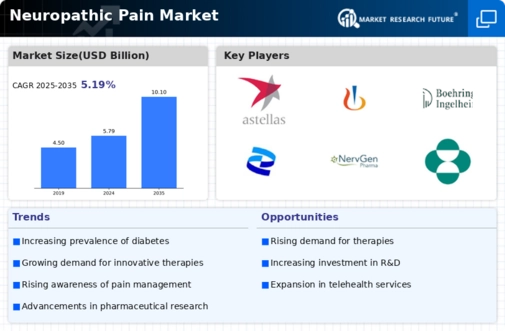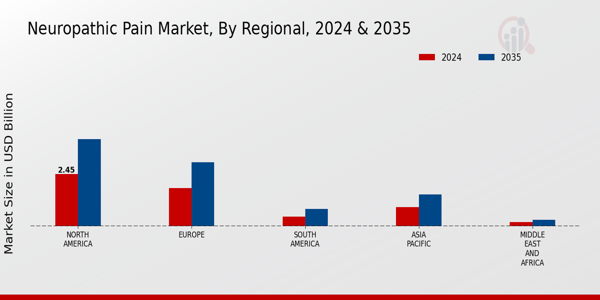Diabetic Neuropathy
Postherpetic Neuralgia
Trigeminal Neuralgia
Chemotherapy-Induced Peripheral Neuropathy
Medications
Physical Therapy
Surgical Procedures
Electrical Stimulation
Oral
Topical
Injectable
Hospitals
Clinics
Home Care
North America
Europe
South America
Asia Pacific
Middle East and Africa
North America Outlook (USD Billion, 2019-2035)
North America Neuropathic Pain Market by Type of Neuropathic Pain Type
Diabetic Neuropathy
Postherpetic Neuralgia
Trigeminal Neuralgia
Chemotherapy-Induced Peripheral Neuropathy
North America Neuropathic Pain Market by Treatment Type
Medications
Physical Therapy
Surgical Procedures
Electrical Stimulation
North America Neuropathic Pain Market by Route of Administration Type
Oral
Topical
Injectable
North America Neuropathic Pain Market by End User Type
Hospitals
Clinics
Home Care
North America Neuropathic Pain Market by Regional Type
US
Canada
US Outlook (USD Billion, 2019-2035)
US Neuropathic Pain Market by Type of Neuropathic Pain Type
Diabetic Neuropathy
Postherpetic Neuralgia
Trigeminal Neuralgia
Chemotherapy-Induced Peripheral Neuropathy
US Neuropathic Pain Market by Treatment Type
Medications
Physical Therapy
Surgical Procedures
Electrical Stimulation
US Neuropathic Pain Market by Route of Administration Type
Oral
Topical
Injectable
US Neuropathic Pain Market by End User Type
Hospitals
Clinics
Home Care
CANADA Outlook (USD Billion, 2019-2035)
CANADA Neuropathic Pain Market by Type of Neuropathic Pain Type
Diabetic Neuropathy
Postherpetic Neuralgia
Trigeminal Neuralgia
Chemotherapy-Induced Peripheral Neuropathy
CANADA Neuropathic Pain Market by Treatment Type
Medications
Physical Therapy
Surgical Procedures
Electrical Stimulation
CANADA Neuropathic Pain Market by Route of Administration Type
Oral
Topical
Injectable
CANADA Neuropathic Pain Market by End User Type
Hospitals
Clinics
Home Care
Europe Outlook (USD Billion, 2019-2035)
Europe Neuropathic Pain Market by Type of Neuropathic Pain Type
Diabetic Neuropathy
Postherpetic Neuralgia
Trigeminal Neuralgia
Chemotherapy-Induced Peripheral Neuropathy
Europe Neuropathic Pain Market by Treatment Type
Medications
Physical Therapy
Surgical Procedures
Electrical Stimulation
Europe Neuropathic Pain Market by Route of Administration Type
Oral
Topical
Injectable
Europe Neuropathic Pain Market by End User Type
Hospitals
Clinics
Home Care
Europe Neuropathic Pain Market by Regional Type
Germany
UK
France
Russia
Italy
Spain
Rest of Europe
GERMANY Outlook (USD Billion, 2019-2035)
GERMANY Neuropathic Pain Market by Type of Neuropathic Pain Type
Diabetic Neuropathy
Postherpetic Neuralgia
Trigeminal Neuralgia
Chemotherapy-Induced Peripheral Neuropathy
GERMANY Neuropathic Pain Market by Treatment Type
Medications
Physical Therapy
Surgical Procedures
Electrical Stimulation
GERMANY Neuropathic Pain Market by Route of Administration Type
Oral
Topical
Injectable
GERMANY Neuropathic Pain Market by End User Type
Hospitals
Clinics
Home Care
UK Outlook (USD Billion, 2019-2035)
UK Neuropathic Pain Market by Type of Neuropathic Pain Type
Diabetic Neuropathy
Postherpetic Neuralgia
Trigeminal Neuralgia
Chemotherapy-Induced Peripheral Neuropathy
UK Neuropathic Pain Market by Treatment Type
Medications
Physical Therapy
Surgical Procedures
Electrical Stimulation
UK Neuropathic Pain Market by Route of Administration Type
Oral
Topical
Injectable
UK Neuropathic Pain Market by End User Type
Hospitals
Clinics
Home Care
FRANCE Outlook (USD Billion, 2019-2035)
FRANCE Neuropathic Pain Market by Type of Neuropathic Pain Type
Diabetic Neuropathy
Postherpetic Neuralgia
Trigeminal Neuralgia
Chemotherapy-Induced Peripheral Neuropathy
FRANCE Neuropathic Pain Market by Treatment Type
Medications
Physical Therapy
Surgical Procedures
Electrical Stimulation
FRANCE Neuropathic Pain Market by Route of Administration Type
Oral
Topical
Injectable
FRANCE Neuropathic Pain Market by End User Type
Hospitals
Clinics
Home Care
RUSSIA Outlook (USD Billion, 2019-2035)
RUSSIA Neuropathic Pain Market by Type of Neuropathic Pain Type
Diabetic Neuropathy
Postherpetic Neuralgia
Trigeminal Neuralgia
Chemotherapy-Induced Peripheral Neuropathy
RUSSIA Neuropathic Pain Market by Treatment Type
Medications
Physical Therapy
Surgical Procedures
Electrical Stimulation
RUSSIA Neuropathic Pain Market by Route of Administration Type
Oral
Topical
Injectable
RUSSIA Neuropathic Pain Market by End User Type
Hospitals
Clinics
Home Care
ITALY Outlook (USD Billion, 2019-2035)
ITALY Neuropathic Pain Market by Type of Neuropathic Pain Type
Diabetic Neuropathy
Postherpetic Neuralgia
Trigeminal Neuralgia
Chemotherapy-Induced Peripheral Neuropathy
ITALY Neuropathic Pain Market by Treatment Type
Medications
Physical Therapy
Surgical Procedures
Electrical Stimulation
ITALY Neuropathic Pain Market by Route of Administration Type
Oral
Topical
Injectable
ITALY Neuropathic Pain Market by End User Type
Hospitals
Clinics
Home Care
SPAIN Outlook (USD Billion, 2019-2035)
SPAIN Neuropathic Pain Market by Type of Neuropathic Pain Type
Diabetic Neuropathy
Postherpetic Neuralgia
Trigeminal Neuralgia
Chemotherapy-Induced Peripheral Neuropathy
SPAIN Neuropathic Pain Market by Treatment Type
Medications
Physical Therapy
Surgical Procedures
Electrical Stimulation
SPAIN Neuropathic Pain Market by Route of Administration Type
Oral
Topical
Injectable
SPAIN Neuropathic Pain Market by End User Type
Hospitals
Clinics
Home Care
REST OF EUROPE Outlook (USD Billion, 2019-2035)
REST OF EUROPE Neuropathic Pain Market by Type of Neuropathic Pain Type
Diabetic Neuropathy
Postherpetic Neuralgia
Trigeminal Neuralgia
Chemotherapy-Induced Peripheral Neuropathy
REST OF EUROPE Neuropathic Pain Market by Treatment Type
Medications
Physical Therapy
Surgical Procedures
Electrical Stimulation
REST OF EUROPE Neuropathic Pain Market by Route of Administration Type
Oral
Topical
Injectable
REST OF EUROPE Neuropathic Pain Market by End User Type
Hospitals
Clinics
Home Care
APAC Outlook (USD Billion, 2019-2035)
APAC Neuropathic Pain Market by Type of Neuropathic Pain Type
Diabetic Neuropathy
Postherpetic Neuralgia
Trigeminal Neuralgia
Chemotherapy-Induced Peripheral Neuropathy
APAC Neuropathic Pain Market by Treatment Type
Medications
Physical Therapy
Surgical Procedures
Electrical Stimulation
APAC Neuropathic Pain Market by Route of Administration Type
Oral
Topical
Injectable
APAC Neuropathic Pain Market by End User Type
Hospitals
Clinics
Home Care
APAC Neuropathic Pain Market by Regional Type
China
India
Japan
South Korea
Malaysia
Thailand
Indonesia
Rest of APAC
CHINA Outlook (USD Billion, 2019-2035)
CHINA Neuropathic Pain Market by Type of Neuropathic Pain Type
Diabetic Neuropathy
Postherpetic Neuralgia
Trigeminal Neuralgia
Chemotherapy-Induced Peripheral Neuropathy
CHINA Neuropathic Pain Market by Treatment Type
Medications
Physical Therapy
Surgical Procedures
Electrical Stimulation
CHINA Neuropathic Pain Market by Route of Administration Type
Oral
Topical
Injectable
CHINA Neuropathic Pain Market by End User Type
Hospitals
Clinics
Home Care
INDIA Outlook (USD Billion, 2019-2035)
INDIA Neuropathic Pain Market by Type of Neuropathic Pain Type
Diabetic Neuropathy
Postherpetic Neuralgia
Trigeminal Neuralgia
Chemotherapy-Induced Peripheral Neuropathy
INDIA Neuropathic Pain Market by Treatment Type
Medications
Physical Therapy
Surgical Procedures
Electrical Stimulation
INDIA Neuropathic Pain Market by Route of Administration Type
Oral
Topical
Injectable
INDIA Neuropathic Pain Market by End User Type
Hospitals
Clinics
Home Care
JAPAN Outlook (USD Billion, 2019-2035)
JAPAN Neuropathic Pain Market by Type of Neuropathic Pain Type
Diabetic Neuropathy
Postherpetic Neuralgia
Trigeminal Neuralgia
Chemotherapy-Induced Peripheral Neuropathy
JAPAN Neuropathic Pain Market by Treatment Type
Medications
Physical Therapy
Surgical Procedures
Electrical Stimulation
JAPAN Neuropathic Pain Market by Route of Administration Type
Oral
Topical
Injectable
JAPAN Neuropathic Pain Market by End User Type
Hospitals
Clinics
Home Care
SOUTH KOREA Outlook (USD Billion, 2019-2035)
SOUTH KOREA Neuropathic Pain Market by Type of Neuropathic Pain Type
Diabetic Neuropathy
Postherpetic Neuralgia
Trigeminal Neuralgia
Chemotherapy-Induced Peripheral Neuropathy
SOUTH KOREA Neuropathic Pain Market by Treatment Type
Medications
Physical Therapy
Surgical Procedures
Electrical Stimulation
SOUTH KOREA Neuropathic Pain Market by Route of Administration Type
Oral
Topical
Injectable
SOUTH KOREA Neuropathic Pain Market by End User Type
Hospitals
Clinics
Home Care
MALAYSIA Outlook (USD Billion, 2019-2035)
MALAYSIA Neuropathic Pain Market by Type of Neuropathic Pain Type
Diabetic Neuropathy
Postherpetic Neuralgia
Trigeminal Neuralgia
Chemotherapy-Induced Peripheral Neuropathy
MALAYSIA Neuropathic Pain Market by Treatment Type
Medications
Physical Therapy
Surgical Procedures
Electrical Stimulation
MALAYSIA Neuropathic Pain Market by Route of Administration Type
Oral
Topical
Injectable
MALAYSIA Neuropathic Pain Market by End User Type
Hospitals
Clinics
Home Care
THAILAND Outlook (USD Billion, 2019-2035)
THAILAND Neuropathic Pain Market by Type of Neuropathic Pain Type
Diabetic Neuropathy
Postherpetic Neuralgia
Trigeminal Neuralgia
Chemotherapy-Induced Peripheral Neuropathy
THAILAND Neuropathic Pain Market by Treatment Type
Medications
Physical Therapy
Surgical Procedures
Electrical Stimulation
THAILAND Neuropathic Pain Market by Route of Administration Type
Oral
Topical
Injectable
THAILAND Neuropathic Pain Market by End User Type
Hospitals
Clinics
Home Care
INDONESIA Outlook (USD Billion, 2019-2035)
INDONESIA Neuropathic Pain Market by Type of Neuropathic Pain Type
Diabetic Neuropathy
Postherpetic Neuralgia
Trigeminal Neuralgia
Chemotherapy-Induced Peripheral Neuropathy
INDONESIA Neuropathic Pain Market by Treatment Type
Medications
Physical Therapy
Surgical Procedures
Electrical Stimulation
INDONESIA Neuropathic Pain Market by Route of Administration Type
Oral
Topical
Injectable
INDONESIA Neuropathic Pain Market by End User Type
Hospitals
Clinics
Home Care
REST OF APAC Outlook (USD Billion, 2019-2035)
REST OF APAC Neuropathic Pain Market by Type of Neuropathic Pain Type
Diabetic Neuropathy
Postherpetic Neuralgia
Trigeminal Neuralgia
Chemotherapy-Induced Peripheral Neuropathy
REST OF APAC Neuropathic Pain Market by Treatment Type
Medications
Physical Therapy
Surgical Procedures
Electrical Stimulation
REST OF APAC Neuropathic Pain Market by Route of Administration Type
Oral
Topical
Injectable
REST OF APAC Neuropathic Pain Market by End User Type
Hospitals
Clinics
Home Care
South America Outlook (USD Billion, 2019-2035)
South America Neuropathic Pain Market by Type of Neuropathic Pain Type
Diabetic Neuropathy
Postherpetic Neuralgia
Trigeminal Neuralgia
Chemotherapy-Induced Peripheral Neuropathy
South America Neuropathic Pain Market by Treatment Type
Medications
Physical Therapy
Surgical Procedures
Electrical Stimulation
South America Neuropathic Pain Market by Route of Administration Type
Oral
Topical
Injectable
South America Neuropathic Pain Market by End User Type
Hospitals
Clinics
Home Care
South America Neuropathic Pain Market by Regional Type
Brazil
Mexico
Argentina
Rest of South America
BRAZIL Outlook (USD Billion, 2019-2035)
BRAZIL Neuropathic Pain Market by Type of Neuropathic Pain Type
Diabetic Neuropathy
Postherpetic Neuralgia
Trigeminal Neuralgia
Chemotherapy-Induced Peripheral Neuropathy
BRAZIL Neuropathic Pain Market by Treatment Type
Medications
Physical Therapy
Surgical Procedures
Electrical Stimulation
BRAZIL Neuropathic Pain Market by Route of Administration Type
Oral
Topical
Injectable
BRAZIL Neuropathic Pain Market by End User Type
Hospitals
Clinics
Home Care
MEXICO Outlook (USD Billion, 2019-2035)
MEXICO Neuropathic Pain Market by Type of Neuropathic Pain Type
Diabetic Neuropathy
Postherpetic Neuralgia
Trigeminal Neuralgia
Chemotherapy-Induced Peripheral Neuropathy
MEXICO Neuropathic Pain Market by Treatment Type
Medications
Physical Therapy
Surgical Procedures
Electrical Stimulation
MEXICO Neuropathic Pain Market by Route of Administration Type
Oral
Topical
Injectable
MEXICO Neuropathic Pain Market by End User Type
Hospitals
Clinics
Home Care
ARGENTINA Outlook (USD Billion, 2019-2035)
ARGENTINA Neuropathic Pain Market by Type of Neuropathic Pain Type
Diabetic Neuropathy
Postherpetic Neuralgia
Trigeminal Neuralgia
Chemotherapy-Induced Peripheral Neuropathy
ARGENTINA Neuropathic Pain Market by Treatment Type
Medications
Physical Therapy
Surgical Procedures
Electrical Stimulation
ARGENTINA Neuropathic Pain Market by Route of Administration Type
Oral
Topical
Injectable
ARGENTINA Neuropathic Pain Market by End User Type
Hospitals
Clinics
Home Care
REST OF SOUTH AMERICA Outlook (USD Billion, 2019-2035)
REST OF SOUTH AMERICA Neuropathic Pain Market by Type of Neuropathic Pain Type
Diabetic Neuropathy
Postherpetic Neuralgia
Trigeminal Neuralgia
Chemotherapy-Induced Peripheral Neuropathy
REST OF SOUTH AMERICA Neuropathic Pain Market by Treatment Type
Medications
Physical Therapy
Surgical Procedures
Electrical Stimulation
REST OF SOUTH AMERICA Neuropathic Pain Market by Route of Administration Type
Oral
Topical
Injectable
REST OF SOUTH AMERICA Neuropathic Pain Market by End User Type
Hospitals
Clinics
Home Care
MEA Outlook (USD Billion, 2019-2035)
MEA Neuropathic Pain Market by Type of Neuropathic Pain Type
Diabetic Neuropathy
Postherpetic Neuralgia
Trigeminal Neuralgia
Chemotherapy-Induced Peripheral Neuropathy
MEA Neuropathic Pain Market by Treatment Type
Medications
Physical Therapy
Surgical Procedures
Electrical Stimulation
MEA Neuropathic Pain Market by Route of Administration Type
Oral
Topical
Injectable
MEA Neuropathic Pain Market by End User Type
Hospitals
Clinics
Home Care
MEA Neuropathic Pain Market by Regional Type
GCC Countries
South Africa
Rest of MEA
GCC COUNTRIES Outlook (USD Billion, 2019-2035)
GCC COUNTRIES Neuropathic Pain Market by Type of Neuropathic Pain Type
Diabetic Neuropathy
Postherpetic Neuralgia
Trigeminal Neuralgia
Chemotherapy-Induced Peripheral Neuropathy
GCC COUNTRIES Neuropathic Pain Market by Treatment Type
Medications
Physical Therapy
Surgical Procedures
Electrical Stimulation
GCC COUNTRIES Neuropathic Pain Market by Route of Administration Type
Oral
Topical
Injectable
GCC COUNTRIES Neuropathic Pain Market by End User Type
Hospitals
Clinics
Home Care
SOUTH AFRICA Outlook (USD Billion, 2019-2035)
SOUTH AFRICA Neuropathic Pain Market by Type of Neuropathic Pain Type
Diabetic Neuropathy
Postherpetic Neuralgia
Trigeminal Neuralgia
Chemotherapy-Induced Peripheral Neuropathy
SOUTH AFRICA Neuropathic Pain Market by Treatment Type
Medications
Physical Therapy
Surgical Procedures
Electrical Stimulation
SOUTH AFRICA Neuropathic Pain Market by Route of Administration Type
Oral
Topical
Injectable
SOUTH AFRICA Neuropathic Pain Market by End User Type
Hospitals
Clinics
Home Care
REST OF MEA Outlook (USD Billion, 2019-2035)
REST OF MEA Neuropathic Pain Market by Type of Neuropathic Pain Type
Diabetic Neuropathy
Postherpetic Neuralgia
Trigeminal Neuralgia
Chemotherapy-Induced Peripheral Neuropathy
REST OF MEA Neuropathic Pain Market by Treatment Type
Medications
Physical Therapy
Surgical Procedures
Electrical Stimulation
REST OF MEA Neuropathic Pain Market by Route of Administration Type
Oral
Topical
Injectable
REST OF MEA Neuropathic Pain Market by End User Type
Hospitals
Clinics
Home Care

















Leave a Comment